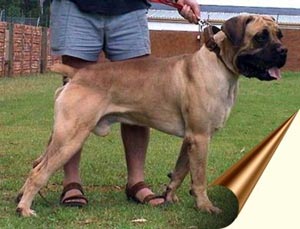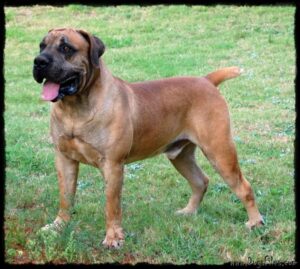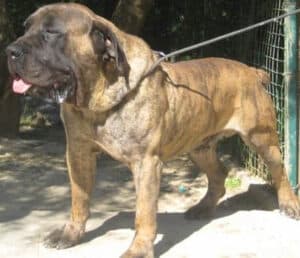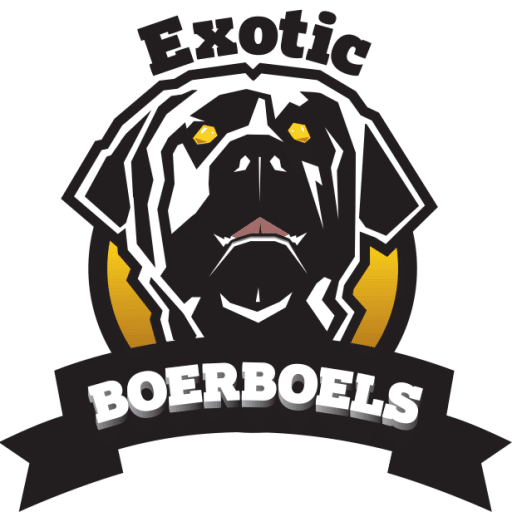
In the tapestry of Boerboel history, particular lineages rise to prominence for their enduring impact on the breed. While the spotlight often shines on well-known bloodlines, unsung contributors like the Grasland/Graswater lineage play a crucial but quieter role in sculpting the Boerboel into the extraordinary breed we know today. Although the original Grasland breeders have since exited the stage, their indelible influence endures through exceptional dogs like Grasland Bronto. This medium-sized, robustly constructed Boerboel encapsulates the Grasland legacy—an exemplary blend of balance, function, and ideal phenotype whose critical influence has inexplicably escaped modern dialogues.
The breeding principles that laid the foundation for Grasland Bronto are steeped in a meticulous blend of science and ethics. Key among these guiding resources is Dr. D. Phillip Sponenberg’s seminal work, “Managing Breeds for a Secure Future,” which sheds light on the intricate art and science of breed conservation. Furthermore, the philosophies advocated by the Monks of New Skete and Dr. Carl Semencic underscore the harmonious blend of temperament and capability in working dogs. This article aims to resurrect the muted legacy of Grasland Bronto, illuminating how his lineage resonates with the wisdom distilled in these pivotal works.

Genetic Diversity and Vigor
Grasland Bronto isn’t just a footnote in Boerboel history; he serves as a foundational pillar for multiple bloodlines and kennels. The breadth of his genetic influence has had a fortifying effect on the breed’s overall gene pool. In doing so, he has lent robustness and adaptability to successive generations.
One of the intriguing elements in Bronto’s genealogy is the frequent appearance of Graswater Lukoe—featured an astonishing 12 times in the initial six generations. While such a high concentration of specific genes could potentially raise red flags about reduced genetic diversity, the calculated reiteration aimed to cement desired physical and temperamental traits in this instance.
This deliberate approach reflects an adept balancing act by the Boerboel breeders: they have managed to reinforce desirable attributes without sacrificing the broader genetic makeup of the Boerboel breed. Grasland Bronto’s extensive use across different kennels has infused much-needed genetic variety, thereby enriching the gene pool.
In line with Sponenberg’s guidelines, these targeted Boerboel breeding strategies have protected and augmented Boerboel’s fundamental characteristics and overall genetic health. Bronto’s dual role—both as a vessel for particular, concentrated genes and as a linchpin for greater genetic diversity—paints him as an exemplary model of purposeful and conscientious genetic management.
We gain a nuanced appreciation of his multifaceted contributions by examining Grasland Bronto through the lenses provided by Dr. D. Phillip Sponenberg and the Monks of New Skete. He serves as a compelling case study of how carefully orchestrated breeding can achieve the delicate balance between preserving specific attributes and maintaining broader genetic health. This often-overlooked legend of the Boerboel world deserves a reevaluation, not just as a historical figure, but as an ongoing influence shaping the breed’s future.
Selection for Functionality
In the context of breeding, functionality often refers to a balance between physical attributes and the ability to perform specific tasks or roles. In the case of Grasland Bronto, however, the primary emphasis during his selection as a stud was not necessarily on his working abilities but rather on the passing of specific conformation traits. This may seem counterintuitive to some breed management practices, particularly when considering the Boerboel’s origin as a working breed focusing on guardianship and protective instincts.
This specialized focus on conformation can be seen as an exception to the more general advice offered in “Managing Breeds for a Secure Future,” where Dr. D. Phillip Sponenberg emphasizes the need to maintain a breed’s core functionalities. The reason behind this specific emphasis in Bronto’s case appears to be a strategic decision by the breeders to reinforce and stabilize physical traits that were considered highly desirable. These traits may include attributes such as size, coat color, bone density, and facial structure.
While some may argue that this focus on conformation over function could potentially dilute the working capabilities of the breed, it is essential to remember that the Boerboel already possesses strong inherent traits for guardianship and companionship. The specialized focus on conformation in Bronto’s case does not necessarily negate his working capabilities but places him in a unique position in breeding programs that aim for a specific set of physical characteristics.

Moreover, by contributing to the Marvell, Nostras, and Afrika bloodlines, Bronto’s specialized traits have been integrated into broader breeding goals. These kennels have had the latitude to either maintain or adapt these traits, depending on their specific focus, thereby creating a more diverse and adaptable set of Boerboels that still carry the foundational attributes of Grasland Bronto.
Thus, Grasland Bronto serves as an exciting example of how breeders, at times, may prioritize certain aspects like conformation while still contributing to the overall diversity and adaptability of the breed. It showcases the complexity and depth involved in breed management and reminds us that functionality can sometimes be interpreted differently, depending on the long-term goals and immediate needs of specific breeding programs.
Controlled Inbreeding and Line-breeding
Regarding Boerboels, their origin from a limited gene pool of approximately 80 dogs adds a unique layer of complexity to the breeding process. Operating within such a restricted genetic framework amplifies the importance of every breeding decision, as each dog carries more weight in the overall genetic makeup of the breed. In his book “Managing Breeds for a Secure Future,” Dr. D. Phillip Sponenberg stresses the significance of using controlled inbreeding and line-breeding as tools for stabilizing desired traits within a breed, mainly when dealing with a limited gene pool.

In such a scenario, the importance of using the “best” dogs—those that most exemplify the breed’s standard in terms of both physical attributes and temperament—cannot be overstated. These are the specimens most likely to pass on the qualities that breeders aim to preserve or enhance, thereby maintaining the overall health and functionality of the breed. Grasland Bronto serves as an illustrative example of this principle, standing out as one of the best in terms of his highly desirable conformation traits, even if his working abilities were not the primary focus of his selection as a stud.
His lineage also highlights the role of controlled inbreeding and line breeding in fixing specific traits within a restricted gene pool. With Graswater Lukoe appearing multiple times in his lineage, the high concentration of these genes is a strategic effort to stabilize and propagate specific attributes. This is a clear application of the principles discussed by Sponenberg, aiming for the consolidation of desirable traits while being mindful of the potential pitfalls, such as loss of genetic diversity and the risk of hereditary diseases.
The case of Grasland Bronto also underscores the broader implication that even within a restricted genetic landscape, strategic breeding decisions can result in robust, healthy, and exemplary individuals. The fact that Bronto’s genetics have been foundational in establishing significant bloodlines like Marvell, Nostras, and Afrika, speaks to the positive outcomes possible through well-managed inbreeding and line-breeding practices despite the challenges presented by a limited gene pool.
Grasland Bronto showcased the intricate balancing act involved in breed management, particularly for a breed like the Boerboel that started from a limited base. His existence and influence reinforce the importance of making informed and strategic choices in selecting the best dogs for breeding, thereby fulfilling the critical roles of preserving the breed’s unique characteristics and ensuring its long-term viability.
Phenotypic Balance
The notion of phenotypic balance is a cornerstone in the art and science of dog breeding, emphasizing the need for a well-rounded individual who excels not just in one or two attributes but across a spectrum of traits. Dr. D. Phillip Sponenberg, in “Managing Breeds for a Secure Future,” discusses the importance of avoiding exaggerations in breed characteristics. Exaggerations often come at a cost—whether it’s compromised health, reduced functionality, or a decline in other essential attributes.
In the case of Boerboels, which are fundamentally working dogs, the utility of each physical trait should be carefully considered. Exaggerated features, such as an oversized head, a massive chest, or excessive bone density, might initially appear attractive but often do not contribute to the breed’s fundamental working ability. In fact, these exaggerated traits can sometimes be detrimental, causing issues like joint problems, reduced mobility, or compromised respiratory function. If these features don’t contribute to improved health and working ability, then their importance diminishes, and they become lower priorities in a breeding program. If they cause adverse effects, they should be consciously selected against.
Grasland Bronto stands as an epitome of phenotypic balance. While he was selected primarily for conformation traits, it’s clear that the breeders were aware of avoiding needless exaggerations that could compromise his health or the functional characteristics inherent to the Boerboel breed. His medium size and robust build not only meets aesthetic standards but also aligns with the functional requirements of a working dog. Unlike dogs bred with extreme features that serve as little more than ‘ornaments,’ Bronto’s physical attributes contribute to his overall functionality and durability.
Being a working dog, a Boerboel must possess the stamina, agility, and strength to perform the tasks it was bred for, whether that’s guarding property or serving as a loyal companion. A well-balanced dog like Grasland Bronto offers significant functional advantages over dogs with exaggerated, non-contributory traits. In essence, every feature should have a purpose, and every purpose should align with the breed’s original function and current needs.
Therefore, Grasland Bronto serves as a valuable example of prioritizing phenotypic balance, effectively demonstrating that breeding for exaggerated traits is unnecessary and could be detrimental to the breed’s future. In line with Sponenberg’s guidance, Bronto represents a thoughtful approach to maintaining a balance between form and function, thereby contributing to the Boerboel’s long-term viability as both a working dog and a companion.
Temperament: The Unsung Trait
While physical traits often capture the most attention in discussions about breeding and lineage, temperament is an equally crucial but frequently overlooked aspect. According to guidance from “Managing Breeds for a Secure Future” by Dr. D. Phillip Sponenberg, a well-rounded breeding program should give due weight to temperament alongside physical traits. This becomes especially pertinent for a working breed like the Boerboel, where the dog’s role extends beyond mere companionship to include safety and security.
The Grasland Bronto bloodline shines in this respect, boasting an impeccable record when it comes to temperament. No temperament issues have been reported from any dogs descended from this lineage. This is not a minor feat but a testament to the thorough and thoughtful selection criteria that breeders applied, in line with best practices in South African (S A) breeding programs. In these programs, the temperament of the breeding stock isn’t just an afterthought but one of the highest priorities.
The rationale behind this focus is clear and practical: temperament must be an unwavering consideration when you rely on a dog for your safety and security. A dog with physical prowess but unpredictable or unstable behavior is not just unreliable but potentially dangerous. In contrast, a well-tempered dog like Grasland Bronto or his descendants can be counted on to act appropriately, whether that involves guarding property, protecting the family, or serving as a loyal companion.
In summary, while Grasland Bronto’s contributions to physical traits across the Boerboel breed are well recognized, his equally significant impact on temperament should not be underestimated. A balanced breeding program acknowledges the intrinsic value of stable, reliable character, particularly for a working breed that is often tasked with responsibilities that directly affect human safety. Grasland Bronto’s lineage exemplifies this holistic approach, marking him not just as an influential progenitor but as a well-rounded contributor to the enduring quality and reliability of the Boerboel breed.



